With a population of over 4 million, Hogs cost the US more than $1.5 billion in annual agricultural damage. That pushed hunters around the country to compete and showcase their talent in capturing them. Although you can snipe them from a distance, using dogs is much more fun.
What are the best hog hunting breeds? It depends on the hunting style you want. For tracking dogs, I’d recommend Redbones. Their cold noses will track the furthest hogs. A Dogo Argentino is your best bet for a catch dog thanks to his incredible build.
Don’t leave just yet! I’ll talk more about these breeds, plus 5 more, in the rest of this article. We’ll also discuss other important questions that concern all hog hunters.
The Best Breeds for Hunting Hogs
We’ll take a look at how those breeds perform against hogs, what they do best, and what they lack.
Blue Lacy Dogs
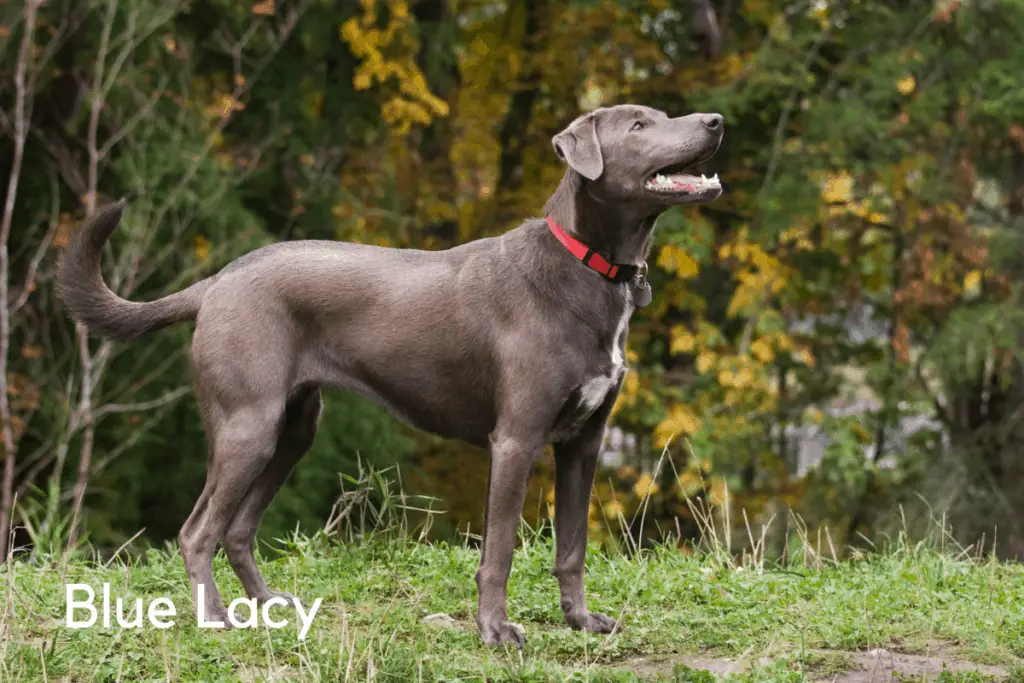
Blue Lacys are among the most famous breeds in the hog hunting world. Simply because they were specifically bred for this task in the 1850s in Texas. Therefore, they have the necessary attitude and skills written in their genes.
Lacys are well known for their superior agility, speed, and stamina. That’s why they serve best as tracking dogs rather than catch dogs.
The only thing I don’t like about them is their relatively hot nose. Don’t get me wrong; they can track hog trails. But they won’t catch older trails as well as a hound.
Nevertheless, when they successfully corner a hog, you’ll watch an unmatched act of courage and grit. They’ll easily contain the sneakiest hogs and bay loudly until you arrive.
Moreover, their intelligence makes them learn notably fast. As a result, training them is a lot easier than other hunting breeds.
As puppies, they have exceptionally high energy. That’s why they won’t be suitable as house pets, especially if you have young kids.
Facts:
Hunting style: Tracking dogs
Temperament: Active and Intelligent
Height: 17-25 inches
Weight: 25 to 50 pounds
Pros:
- Superior speed and agility
- Intelligent and courageous
- Can be easily trained
Cons:
- Relatively hot nose
- Can’t physically engage with hogs
Black Mouth Curs
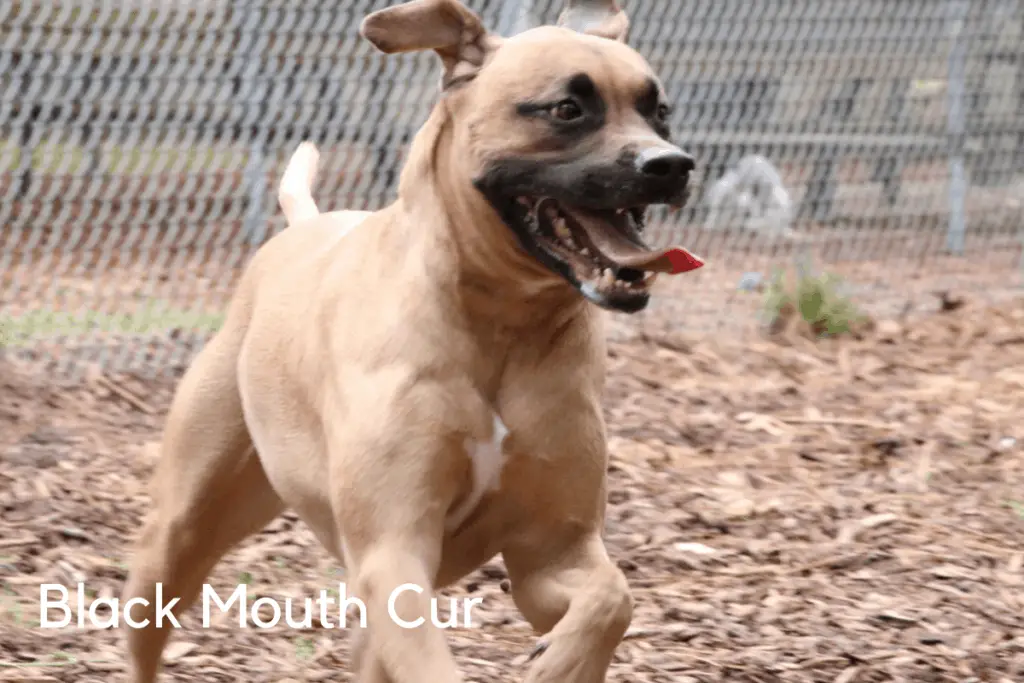
Simply put, Black Mouth Curs are one of the most versatile breeds in hog hunting. First of all, they have a well-muscled build that makes them a reliable match against the strongest hogs.
Furthermore, they have a strong nose with which they can trail and track semi-old trails. Therefore, we can agree that a pack of Black Mouth Curs will track and catch hogs on their own.
Personally, I think that they look absolutely cool with the black, square-shaped muzzle, and the brown coat. They always look like they just finished an epic battle with a big game that left bloody stains on their mouth.
Inside the house, they also serve as loyal pets. But it’s important to give them the required physical exercise, or else they’ll show signs of aggression. They can also be used for other purposes like protection and herding.
If you have young kids in your household, don’t leave them unattended with a Black Mouth cur as they like to play quite rough.
Facts:
Hunting style: Catch and tracking dogs
Temperament: Fearless and trusting
Height: 16 to 25 inches
Weight: 40 to 95 pounds
Pros:
- Well-muscled
- Strong noses
- Can be kept as house pets
Cons:
American Bulldogs
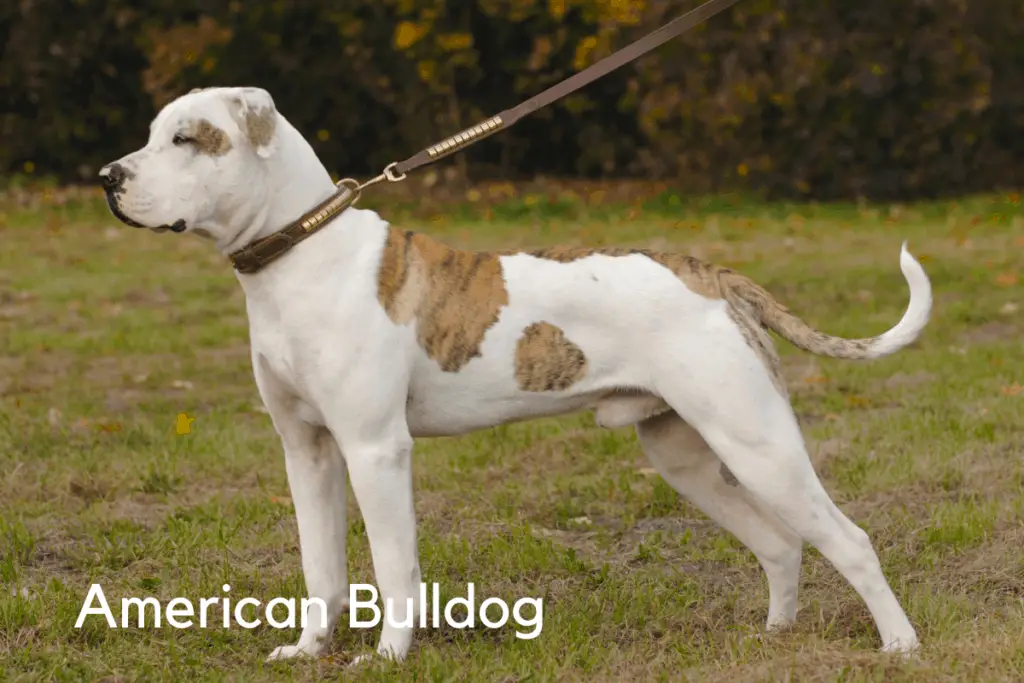
Needless to say, American Bulldogs are among the classic catch breeds currently in the US. Thanks to their extremely strong builds, no hogs wouldn’t stand a chance against them.
It’s believed that they were bred from the English bulldog around the 17th century. Farmers and ranchers widely used them for protection and herding. However, they thrived exceptionally well in the southern states as they were super helpful with feral hogs.
American Bulldogs are characterized by their strong locking jaws. Their lower jaw is usually longer than the upper, a bite known as a reverse scissor bite. This makes their grip even tighter.
Despite their bulky appearance, they show surprising speed in the hunt. The speed alongside their aggressiveness won’t allow any hog to outrun them.
The sole tradeoff lies in their noses. As you might already know, they don’t track the scent as well as other hunting breeds.
Give them the necessary exercise and they’ll also be great as pets. Don’t let their hunting style fool you, though. They show exceptional affection for all family members, especially kids.
Facts:
Hunting style: Catch dogs
Temperament: Loyal and confident
Height: 22-25 inches
Weight: 75-100 pounds
Pros:
- Strong build and high speed
- Locking jaws with a reverse scissor bite
- Affectionate as house pets
Cons:
- They don’t track scents well
Redbone Coonhounds
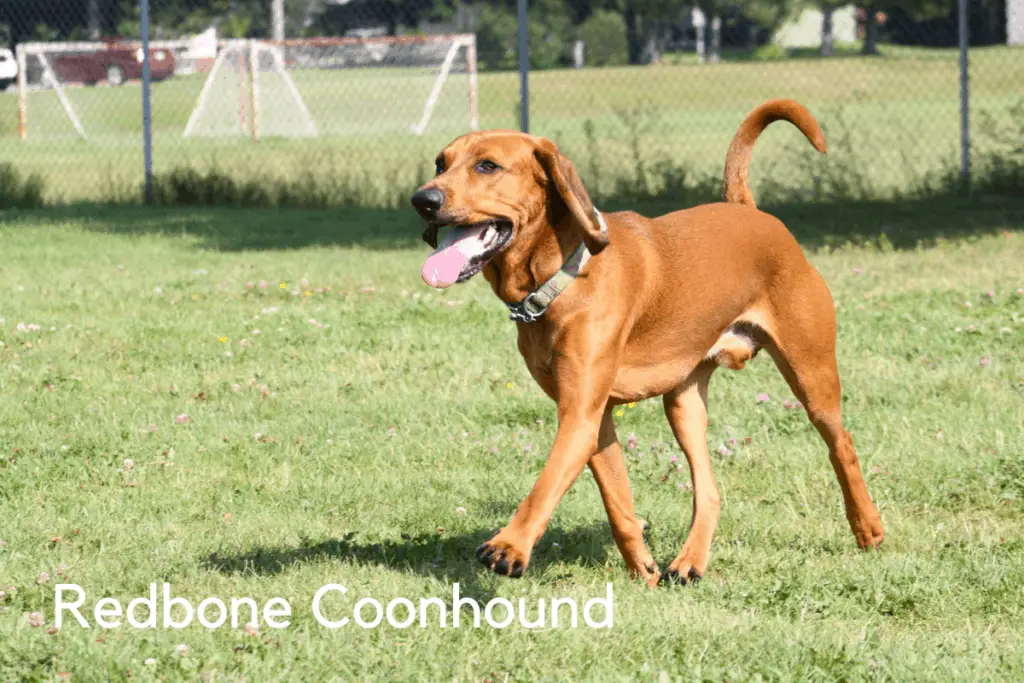
Redbones were initially bred to hunt raccoons in the 19th century. They had an amazing performance in tracking thanks to their unmatched cold noses. That’s why they gained wide popularity in hunting big game.
My most favorite thing about Redbones is their baying. When they successfully corner a hog, they’ll sound a distinctive bay to let you know about their victory.
It’s important to train your Redbone on following your orders. Otherwise, they’ll prefer to follow their nose and leave you behind.
If you’re looking for a pet to live inside, don’t consider Redbones. They’re extremely energetic with a high urge to use their noses in tracking, which won’t be available in apartments.
It’s also important to note that they have a quite delayed mental maturation. Puppies reach full size at about 1 year. But it takes another year and a half for their minds to develop completely.
Within this period, they’ll tend to play rough, which is another reason that prevents having them as pets.
Facts:
Hunting style: Mainly tracking dogs
Temperament: Amiable and eager to please
Height: 22-27 inches
Weight: 45-70 pounds
Pros:
- Incredibly potent, cold noses
- Sound distinctive bayings upon cornering a hog
- Perseverant in tough hunts
Cons:
- They aren’t suitable as house pets
- They can ignore commands unless properly trained
Treeing Walker Coonhound
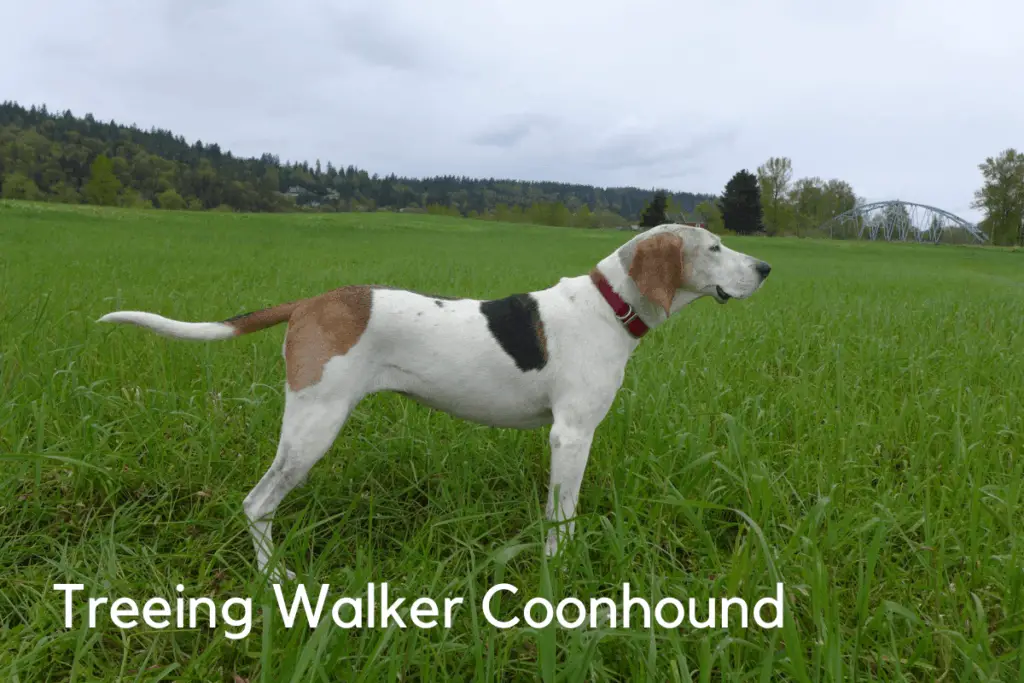
Walkers are mainly known for their speed. That’s why it’s highly common to see them in field trials.
Despite being Coonhounds, Walkers don’t have a cold nose. In fact, they often ignore older scents to go after the fresher ones. This may present a problem if you’re going after a distant, sneaky hog.
However, if they successfully spotted a hog, they’ll tirelessly follow it until it’s cornered, no matter how long it takes. This happens thanks to their exceptional endurance and perseverance.
Just like Redbones, Walkers bay uniquely when they corner a prey. This gets especially helpful if you’re hunting at night or if the dog gets too far.
In a house, Walkers would be highly devoted to your family and kids. But they wouldn’t be as friendly toward other pets, especially the smaller ones. Moreover, their droopy ears can easily develop an infection unless they’re properly cleaned.
Facts:
Hunting style: Tracking dogs
Temperament: highly enduring and even-tempered
Height: 22-27 inches
Weight: 50-70 pounds
Pros:
- High speed during the hunt
- Endurant and perseverant
- Affectionate as pets
Cons:
- Their ears are prone to infection
- They can be aggressive toward other small pets
Pit Bulls
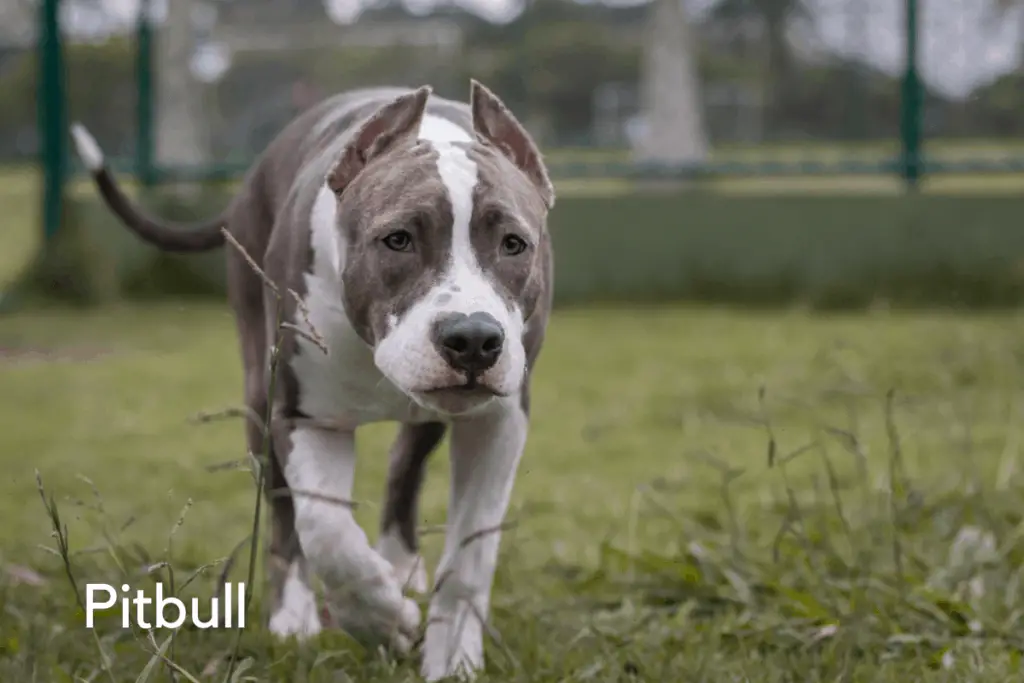
I couldn’t include Bulldogs without mentioning their similarly-looking cousins, the Pit Bulls. In fact, Pit Bulls were bred from Bulldogs and Terriers to combine strength and agility respectively.
These characteristics made Pit Bulls suitable for harsh blood sports like bull-baiting, bear-baiting, and dog fights. After these sports were banned in most countries, Pit Bulls were consequently used for hunting big game such as feral hogs.
When Pit Bulls catch a hog, there’s no way it could run. That’s because of their super-strong jaws and wide skulls. They also tend to shake their head vigorously to tear the prey’s flesh even further.
Aside from their physical superiorities, Pit Bulls show extreme obedience if properly trained. This gives a seamless and effective hunting experience.
Although they’re known for aggressive behavior, Pit Bulls are affectionate toward their owners by nature.
However, some people don’t spend enough time in their training and socialization, or they don’t do it with sufficient firmness. In this case, Pit Bulls might hurt strangers and even their owners.
Facts:
Hunting style: Catch dogs
Temperament: Obedient and fierce
Height: 18-24 inches
Weight: 25-60 pounds
Pros:
- Powerful jaws and tearing bite
- Highly obedient
- Strong build
Cons:
- Can become aggressive unless they’re properly trained
Dogo Argentino
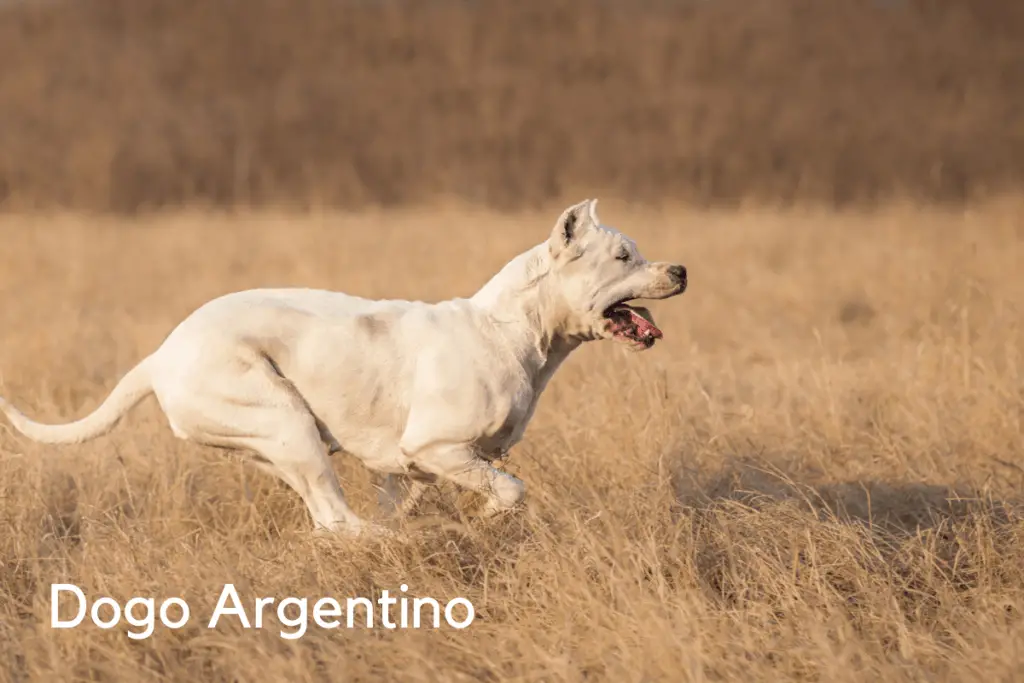
Larger and more powerful than Pit Bulls, Dogos are my favorite catch dogs. As their name implies, they were initially bred in Argentina to hunt wild hogs living in its forests.
Thanks to their powerful build, they can take down almost any hog individually. However, it’s better to pair them with any tracking dog to compensate for their relatively weak nose.
Their bite is quite similar to the Pit Pulls. They tend to pierce their molars deep inside the prey, making it impossible to fight back.
Unlike Pit Bulls, Dogos were selectively bred for hunting rather than fighting. That’s why you can always see them as loyal and friendly pets.
Nevertheless, you’d have to fulfill their exercise needs to maintain their superior muscle structure.
On the downside, their strong prey-drive tends to make them aggressive toward smaller pets unless they were raised together.
Facts:
Hunting style: Catch dogs
Temperament: Friendly and alert
Height: 24-26 inches
Weight: 88-100 pounds
Pros:
- Extremely powerful build
- Potent bite
- Friendly toward their owners
Cons:
- Can be aggressive toward smaller pets
How to Train Your Dog for Hog Hunting
To familiarize your dogs with hog hunting, it’s preferred to use small domesticated pets. The actual training procedures differ according to whether the dog is a catch or a tracking dog.
Training Tracking Dogs
Put your dog together with a small pig inside a fenced area like a pen. Tease the dog and get him excited for harassing the pig. It’s important to reward him for showing aggressiveness.
Once the dog is aggressive enough, walk the pig on a leash into the wilderness, so that it builds a scent trail. After getting far enough, tie it to a tree. Then, take your dog to that area and encourage him on tracking the scent.
Upon reaching the hog, praise your dog with treats and encourage him to try and corner the pig. Repeat the process several times before taking your dog on an actual hunt with other experienced dogs.
Training Catch Dogs
Apply the same method used with tracking dogs, but place the pig inside a cage. This way, the dog will attack aggressively once you get the pig out of the cage.
It’s important to teach your catch dogs to release the pig on your command. Use a toy or a rope to distract them and reward them only after release. This way, you can safely dispatch hogs without having to haul your dogs.
Frequently Asked Questions
If you’re new to hunting hogs, here are answers to a few questions that might pop up.
What is the difference between a tracking dog and a catch dog?
Tracking dogs, aka bay dogs, start the hunt by trailing the scent of their prey. That’s why it’s important to choose a breed with a cold nose, like Redbones, to be able to track old scents.
After tracking dogs successfully spot a hog, they should chase and corner it. Then, they should bay to inform the hunters, and other dogs, about their location. Baying is also important to intimidate the hog even more.
Once the hog is cornered, catch dogs come into play. They should be courageous with a strong build and a powerful bite to go toe-to-toe with the angry and burly hogs. That’s why Dogo Argentino is my favorite breed for this job.
How many dogs do you need to hunt hogs?
It depends. First things first, your pack must include both catch and tracking dogs for maximum efficiency. Deciding how many of each depends on your situation.
For example, tracking hogs in the piney woods of texas might be difficult, so you may require 3-4 tracking dogs and 1-2 catch dogs.
On the other hand, there are hogs that can weigh up to 700 pounds. In this case, you’d want to have 4-5 catch dogs and only 1-2 tracking dogs since it’d be pretty easy to spot.
It’s important to note that some states impose a maximum number of dogs per pack. So ask about the regulations before embarking on the hunt.
What do you do when your dog bays up or catches a hog?
If your dog bays up a hog, you should try and shoot it with your rifle. However, this won’t be always safe since the hog can suddenly move and attack.
Therefore, it’s important to have catch dogs in your pack. Once these dogs grab the hog by the neck, you can easily dispatch it with a knife.
To do this, ask one of your peers to grab the hog by its hind-legs to pin it down completely. Then, raise one of the hog’s forelegs and stab the armpit. This is the most vulnerable part that leads directly to the heart and/or the lungs.
If you don’t wish to get blood on your hands, you can still shoot your rifle at the same spot. Avoid headshots because it may hurt your dogs.
Do people eat hogs?
YES! Make sure you cook to the proper temperature… like all Pork.
Where are hogs found in the US?
The highest hog population is found in Texas. It currently has over 2.5 million hogs statewide. Hog season is open year-round and you don’t need more than a general hunting license. If you wish to hunt at night, you have to notify the local game warden beforehand.
Florida comes in second place. In fact, hogs are the second most hunted animals in Florida after the white-tailed deers. Similarly, the hunt is allowed year-round with nothing but a general hunting license. However, taking the meat is restricted during the spring season.
Louisiana ranks third with about 500,000 hogs statewide and hunting is legal year-round.
How do you protect your catch dogs?
Paw boots can be used to protect their paws from rough terrains, sharp rocks, or even tree roots. Vests are also useful during the hunt. There are visibility vests that aid in night hunting, flotation vests for hunting around water, and winter vests, which are pretty self-explanatory.
And last but not least, Kevlar vests. These are incredibly important to protect the dog in close fights with hogs. Some brands design them with neck extensions to protect this vital area.
To Sum Up
Hunting hogs isn’t only fun, you’d also serve your community by decreasing their damage to agricultural properties.
Redbones will perfectly track a hog’s scent and a Dogo Argentino would courageously attack it. Whatever breed you choose, make sure you provide the necessary training and protection for your dog as hogs can be dangerous.
Take care, be patient, and good luck!
